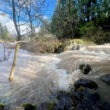Alex Paul
For The New Era
No one was surprised March 29 when officials from the U.S. Army Corps of Engineers told a crowd of 46 that an unusually dry winter has left them with few choices about filling the 13 reservoirs under their control. Most reservoirs won’t be full any time this season.
Foster reservoir will be kept up but Green Peter definitely won’t be anywhere near maximum pool level unless the area experiences an extremely wet spring.
The meeting came after a day of hard rain, but Erik Petersen, operations manager for the Willamette Valley Projects, said it was too little too late.
“It’s a good turn of events, but we’re still far behind normal,” Petersen said. “There are many demands for the water stored behind the dams. The situation can change dramatically though if we get a rainy spring.”
As of last week, the Willamette Valley was about 30 percent behind normal rainfall curves and snowpack was also extremely low.
“We started the year kind of normal,” said Brad Bird, climate and water management specialist. “But the winter was extremely dry.”
He said 1977 was an even dryer year, but 2004-’05 is comparable to 2001 statistically.
“Snowpack is just 23 percent of normal,” he added.
November rainfall was 50 percent of normal, December was 70 percent of normal, and January and February were at 40 percent of normal, Bird said.
“During the last 60 months, there were only eight or nine months when rainfall was above average,” Bird said.
Matt Rae, Willamette Basin coordinator, said the project encompasses 13 reservoirs, 11 multi-purpose and two re regulators, as well as 100 miles of bank protection works.
“Foster dam is a cross between the two types of dams,” Rae said. “It’s a smaller area but it acts as a regulator for Green Peter.”
Of the total water held in the reservoirs, Foster holds two percent; Green Peter, 16 percent; Detroit, 18 percent; Lookout Point, 19 percent; Hills Creek, 12 percent; Fern Ridge, six percent; Fall Creek, seven percent; Cougar, nine percent.
The dams were built with the primary purpose of flood control but also are used for hydropower generation, navigation, irrigation, fish and wildlife, recreation, water quality, and municipal and industrial water supplies.
“In a dry year, it becomes extremely more difficult to balance all of those needs,” the group was told.
Water flows to enhance fish passage has been important, especially since 1999.
The drawdown priority list for the dams this season in order will be: Lookout Point, Green Peter, Hills Creek/Cougar, Blue River, Fall Creek/Cottage Grove, Dorena, Fern Ridge, Foster and Detroit.
Foster and Detroit will have the highest priority to remain full through the summer recreation season. Dexter and Foster reservoirs will be filled.
Fern Ridge, the oldest dam in the system, is scheduled to undergo extensive refurbishing this season and next, which could drive recreationists to Foster reservoir.
The Corps said the public can expect the following:
— Do not expect any storage reservoirs to be full.
— Dexter and Foster reservoirs will be full.
— All other reservoirs will be far below normal water levels.
— Many boating and swimming facilities will not be usable.
— All water storage may be needed to meet downstream requirements before summer is over.
Audience members asked if the Corps would consider opening roads on the south side of Green Peter to provide access for bank fishing. Officials said they would look into that possibility.
Brian Carroll of Linn County Parks Department asked if the Foster reservoir would be “swept” after the smolt passage season to clear debris for summer boating and recreation?
He was told no changes were planned this season.
Jack Legg, owner of DanDee Sales asked if the Corps might consider replacing a log boom that used to help keep debris out of the main body of the lake?
The boom, officials said, wasn’t efficient and probably would not be replaced.
Development of another boat ramp at Calkins Point on Foster reservoir is a possibility, officials said. The Oregon State Marine Board has the ramp on its six year plan, Brian Carroll said.
“If we applied for it this year and were successful, we could start the permit process next fall,” Carroll said.
For more information about the Corps’ water management strategies, visit their web site at https://www.nwp.usace.army.mil.




